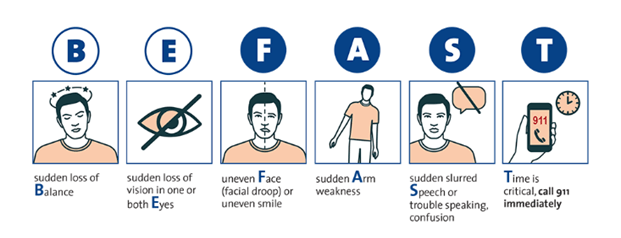Stroke Awareness Month: Tips to Help Prevent and Respond to a Stroke
May 1, 2019
Queens, New York
Stroke is the leading cause of permanent disability in the U.S. and the fifth leading cause of death. In recognition of National Stroke Awareness Month, NewYork-Presbyterian Queens is sharing information on stroke risk and prevention.
“Strokes are a severe medical emergency, and time is of the essence for successful treatment,” said Dr. Gary L. Bernardini, chairman of the Department of Neurology at NewYork-Presbyterian Queens and an attending neurologist at NewYork-Presbyterian/Weill Cornell Medical Center. “When you see the symptoms of a stroke, it is critical to respond quickly and seek immediate medical attention. By recognizing and quickly responding to the signs of stroke, you can potentially save your own life or the life of a family member or friend.”
Here, neurology experts at NewYork-Presbyterian Queens share the critical warning signs that a stroke is occurring, as well as stroke prevention tips.
To identify a stroke, remember: “BE FAST”

Remembering and applying the acronym “BE FAST” can help people identify the most common symptoms of a stroke. Knowing the symptoms will help a victim get the treatment they need quickly and likely lead to a better recovery:
Prevention tips:
- Monitor your blood pressure. High blood pressure is the biggest contributor to a risk of stroke in both men and women. Always monitor your blood pressure, and if it is elevated, consult a physician to put together a plan to get it to a healthier level.
- Maintain a healthy weight. According to the American Heart Association, obesity is commonly linked to high blood pressure, hypertension and diabetes, which can cause a stroke. Work with your doctor to create a personal weight loss strategy.
- Exercise. Exercise contributes to losing weight and lowering blood pressure, but it also stands on its own as an independent stroke reducer. Exercise at a moderate intensity at least five days a week, whether that is a walk around your neighborhood or joining a local gym.
- Modify your diet. Adjustments in your diet can be one of the biggest factors in preventing a stroke. According to the National Stroke Association, some diet modifications include: reducing your sodium intake, avoiding high-cholesterol foods, eating multiple servings of fruits and vegetables every day and eating whole grains.
- Limit alcohol. Drinking an excessive amount of alcohol – more than one to two drinks a day – can substantially increase your risk of stroke. Try to limit your alcohol consumption.
- Quit smoking. According to the World Health Organization, smoking can make you up to four times more likely to have a stroke. If you smoke, consult your doctor on the best plan to help you quit.
- Schedule your physical. Knowing numbers like your blood pressure, cholesterol and blood sugar will help you know where you stand in improving your health and lowering your risk of stroke and other cardiovascular-related illnesses.
- Know your family history. Talk with your family members to see if you have a family history of stroke. This can establish your risk of having a stroke and help you and your physician plan out the necessary precautions.
By knowing the risk factors and symptoms, you can help prevent and mitigate the effects of a stroke. For more information on how NewYork-Presbyterian Queens is committed to providing the very best stroke treatment and care, visit https://www.nyp.org/queens/clinical-services/neurosciences/the-stroke-center.
NewYork-Presbyterian Queens
NewYork-Presbyterian Queens, located in Flushing, New York, is a community teaching hospital affiliated with Weill Cornell Medicine, serving Queens and metro New York residents. The 535-bed tertiary care facility provides services in 14 clinical departments and numerous subspecialties. Annually, 15,000 surgeries and 4,000 infant deliveries are performed at NewYork-Presbyterian Queens. With its network of affiliated primary and multispecialty care physician practices and community-based health centers, the hospital provides approximately 162,000 ambulatory care visits and 124,000 emergency service visits annually. For more information, visit nyp.org/queens.


